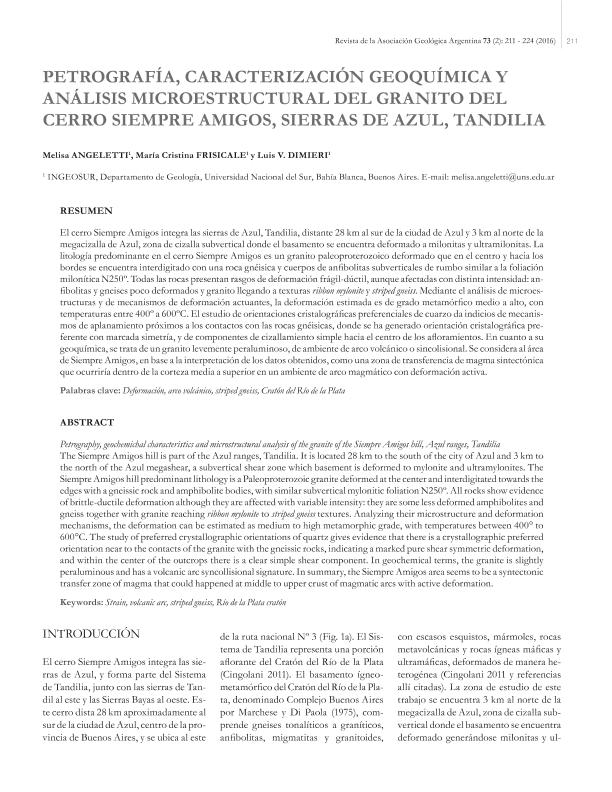Mostrar el registro sencillo del ítem
dc.contributor.author
Angeletti, Melisa

dc.contributor.author
Frisicale, Maria Cristina

dc.contributor.author
Dimieri, Luis Vicente

dc.date.available
2020-07-28T21:15:10Z
dc.date.issued
2016-08
dc.identifier.citation
Angeletti, Melisa; Frisicale, Maria Cristina; Dimieri, Luis Vicente; Petrografía, caracterización geoquímica y análisis microestructural del granito Siempre Amigos, Sierras de Azul, Tandilia; Asociación Geológica Argentina; Revista de la Asociación Geológica Argentina; 73; 2; 8-2016; 211-224
dc.identifier.issn
1669-7316
dc.identifier.uri
http://hdl.handle.net/11336/110500
dc.description.abstract
El cerro Siempre Amigos integra las sierras de Azul, Tandilia, distante 28 km al sur de la ciudad de Azul, 3 km al norte de la Megacizalla de Azul (MCA), zona de cizalla subvertical donde el basamento se encuentra deformado a milonitas y ultramilonitas (Frisicale et al., 1999). La litología predominante es un granito paleoproterozoico deformado que en el centro y hacia los bordes se encuentra interdigitado con una roca migmatítica y diques de anfibolitas, subverticales con rumbo similar a la foliación milonítica N250º. Todas las rocas presentan rasgos de deformación frágil-dúctil, aunque afectadas por ella con distinta intensidad: anfibolitas y migmatitas poco deformadas y granito llegando a texturas ribbon mylonite y striped gneiss. Mediante el análisis de microestructuras y de mecanismos de deformación actuantes, la deformación estimada es de grado metamórfico medio a alto, con temperaturas entre 400º a 600ºC. El estudio de las orientaciones cristalográficas preferenciales (OPC) de cuarzo dan indicios de mecanismos de aplanamiento próximos a los contactos con las rocas migmatíticas donde se ha generado orientación cristalográfica preferente con marcada simetría, y de componentes de cizallamiento simple hacia el centro de los afloramientos. En cuanto a su geoquímica, se trata de un granito levemente peraluminoso, de ambiente de arco volcánico, sincolisional a postorogénico. Se considera al área de Siempre Amigos, en base a la interpretación de los datos obtenidos, como una zona de transferencia de magma sintectónica que ocurriría dentro de la corteza media a superior en un ambiente de arco magmático con deformación activa.
dc.description.abstract
The Siempre Amigos hill is part of the Azul ranges, Tandilia. It is located 28 km to the south of the city of Azul and 3 km to the north of the Azul megashear, a subvertical shear zone which basement is deformed to mylonite and ultramylonites. The Siempre Amigos hill predominant lithology is a Paleoproterozoic granite deformed at the center and interdigitated towards the edges with a gneissic rock and amphibolite bodies, with similar subvertical mylonitic foliation N250º. All rocks show evidence of brittle-ductile deformation although they are affected with variable intensity: they are some less deformed amphibolites and gneiss together with granite reaching ribbon mylonite to striped gneiss textures. Analyzing their microstructure and deformation mechanisms, the deformation can be estimated as medium to high metamorphic grade, with temperatures between 400° to 600°C. The study of preferred crystallographic orientations of quartz gives evidence that there is a crystallographic preferred orientation near to the contacts of the granite with the gneissic rocks, indicating a marked pure shear symmetric deformation, and within the center of the outcrops there is a clear simple shear component. In geochemical terms, the granite is slightly peraluminous and has a volcanic arc syncollisional signature. In summary, the Siempre Amigos area seems to be a syntectonic transfer zone of magma that could happened at middle to upper crust of magmatic arcs with active deformation.
dc.format
application/pdf
dc.language.iso
spa
dc.publisher
Asociación Geológica Argentina
dc.rights
info:eu-repo/semantics/openAccess
dc.rights.uri
https://creativecommons.org/licenses/by-nc/2.5/ar/
dc.subject
DEFORMACIÓN
dc.subject
ARCO VOLCÁNICO
dc.subject
STRIPED GNEISS
dc.subject
CRATÓN DEL RÍO DE LA PLATA
dc.subject.classification
Geología

dc.subject.classification
Ciencias de la Tierra y relacionadas con el Medio Ambiente

dc.subject.classification
CIENCIAS NATURALES Y EXACTAS

dc.title
Petrografía, caracterización geoquímica y análisis microestructural del granito Siempre Amigos, Sierras de Azul, Tandilia
dc.title
Petrography, geochemichal characteristics and microstructural analysis of the granite of the Siempre Amigos hill, Azul ranges, Tandilia
dc.type
info:eu-repo/semantics/article
dc.type
info:ar-repo/semantics/artículo
dc.type
info:eu-repo/semantics/publishedVersion
dc.date.updated
2020-06-22T14:09:54Z
dc.identifier.eissn
1851-8249
dc.journal.volume
73
dc.journal.number
2
dc.journal.pagination
211-224
dc.journal.pais
Argentina

dc.journal.ciudad
Ciudad Autónoma de Buenos Aires
dc.description.fil
Fil: Angeletti, Melisa. Consejo Nacional de Investigaciones Científicas y Técnicas. Centro Científico Tecnológico Conicet - Bahía Blanca. Instituto Geológico del Sur. Universidad Nacional del Sur. Departamento de Geología. Instituto Geológico del Sur; Argentina
dc.description.fil
Fil: Frisicale, Maria Cristina. Consejo Nacional de Investigaciones Científicas y Técnicas. Centro Científico Tecnológico Conicet - Bahía Blanca. Instituto Geológico del Sur. Universidad Nacional del Sur. Departamento de Geología. Instituto Geológico del Sur; Argentina
dc.description.fil
Fil: Dimieri, Luis Vicente. Consejo Nacional de Investigaciones Científicas y Técnicas. Centro Científico Tecnológico Conicet - Bahía Blanca. Instituto Geológico del Sur. Universidad Nacional del Sur. Departamento de Geología. Instituto Geológico del Sur; Argentina
dc.journal.title
Revista de la Asociación Geológica Argentina
dc.relation.alternativeid
info:eu-repo/semantics/altIdentifier/url/http://ppct.caicyt.gov.ar/index.php/raga/article/view/6621
Archivos asociados
